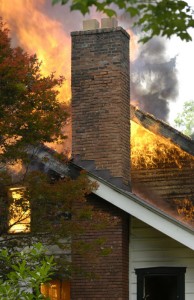How to handle a chimney fire
Homeowners hope they never have to deal with a fire, but it’s something every homeowner should be prepared for. If your home has a fireplace or heating stove, you also should be prepared to deal with a chimney fire.
Recognizing the signs of a chimney fire
 First, you should know the signs of a chimney fire. Oftentimes, chimney fires are extremely dramatic and obvious. Flames and sparks shoots out the top of the chimney, dense smoke billows out, and people inside the home hear a roaring noise like a low-flying plane. Other times, however, chimney fires are far more subtle. Some smoke may begin entering the house, or there may be a popping or “raining” sound from inside the chimney.
First, you should know the signs of a chimney fire. Oftentimes, chimney fires are extremely dramatic and obvious. Flames and sparks shoots out the top of the chimney, dense smoke billows out, and people inside the home hear a roaring noise like a low-flying plane. Other times, however, chimney fires are far more subtle. Some smoke may begin entering the house, or there may be a popping or “raining” sound from inside the chimney.
Responding to a chimney fire
If you believe you are experiencing a chimney fire, your first priority should be to get everyone out of the home safely. While most metal chimney are made to withstand a chimney fire, there is a risk that the fire could escape and ignite your home’s structure. Because of that risk, you should immediately call the fire department. If you feel safe doing so, you can close the doors to the fireplace, and turn off any fans or blowers. Once outside, you can spray water on your roof to prevent any sparks coming from the chimney from igniting your roof.
Following a chimney fire, your chimney should be inspected by a certified chimney sweep before you attempt to burn another fire. A sweep will clean the chimney and inspect the structure. While metal flues can withstand temperatures up to 2,000 degree, they still may be damaged by a fire. The extreme temperatures of a chimney fire can cause major damage to a masonry chimney. Mortar can melt and bricks can crack, compromising the chimney structure.
Preventing a chimney fire
As the saying goes, “Clean chimneys don’t catch fire.” The majority of chimney fires are caused by a buildup of creosote, which is extremely flammable. The best way to protect your home from a chimney fire is to have your chimney swept by a certified chimney sweep at least once a year, and potentially more frequently if you rely on a woodstove as a main source of heat. Your chimney sweep will remove all creosote buildup from your flue, and will look for any signs of chimney damage or weakness.
Creosote forms when smoke cools near the top of your flue, causing condensation. Burning properly seasoned hardwood that is the right size for your fireplace can slow the buildup of creosote in your fireplace. Also, make sure you always burn fires with your damper fully open, and if you have an open-hearth fireplace, never close the fireplace doors when a fire is burning. Having a partially closed damper or closed fireplace doors interrupts the draft of smoke out of your chimney, causing smoke to linger longer and encouraging creosote buildup.
If you’re overdue for a chimney sweeping, or if you’re concerned that your chimney has experienced a fire, call the experts at Chief Chimney Services. We can help keep your home and family safe from the risk of a chimney fire.
